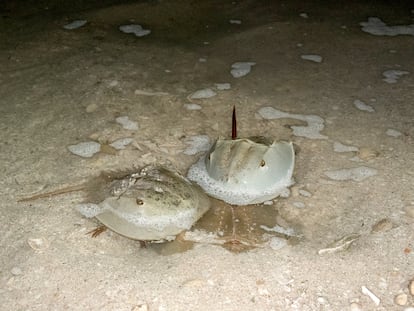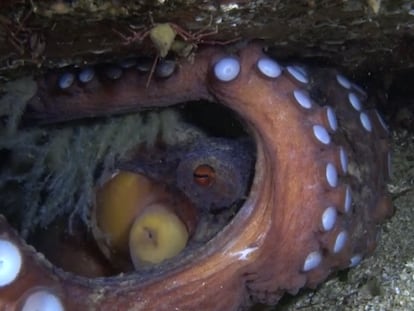Embryos that learn inside the egg
Some animal species learn to recognize predators and modify their behavior to survive before they hatch

Eggs are an appetizing and coveted snack for many animals. They are rich in nutrients and easily captured since embryos can’t run away. The spawn of pharaoh cuttlefish (Sepia Pharaonis) is no exception. Even though these eggs are enveloped in a substrate, they are highly vulnerable to the many predators that hungrily scour the seabed. It might seem that developing cuttlefish are doomed to waiting until they can hatch and fight for their lives, but this is not true. These embryos sense and learn from their environment, and can modify their behavior to survive.
A 2020 study published in Learning & Behavior showed that unlike the common cuttlefish (Sepia officinalis), which clouds its egg sacs with ink, pharaoh cuttlefish produce completely transparent egg sacs. This enables the embryos to perceive their environment as soon as they develop sight. Like other eggs, chemicals can permeate the sac, enabling embryos to smell predators. These characteristics enabled the authors of the study to test the learning ability of pharaoh cuttlefish embryos without penetrating the egg capsule.
Ink is a defense mechanism used by cephalopods such as cuttlefish and squid to evade predators. It’s also an alarm signal for others. Prey can sometimes recognize predators innately, but they also learn to recognize them by association. For example, if a squid sees another squid releasing ink every time it encounters a certain type of fish, it learns that the fish is dangerous.
This study found that the pharaoh cuttlefish embryos at first demonstrated no reaction to a clownfish in the same tank, since it’s not a typical predator. However, the scientists started releasing ink every time they put a clownfish in the tank to see if the embryos would associate it with danger. By the fourth day, the mere presence of a clownfish triggered the typical anti-predator response of a cuttlefish.
While this experiment proved embryo awareness and learning behavior, what can an embryo do to defend itself? Cuttlefish are experts in camouflage. To avoid detection, they can change color and blend in with their surroundings. But this alone is not enough to avoid detection by sharks in the open ocean.
Pharaoh cuttlefish embryos develop in transparent eggs that enable them to perceive nearby dangers and survive by adapting
All aquatic creatures generate a small electric field around their bodies. While this capability is not well understood, scientists know is not produced by muscular activity, since an anesthetized fish can maintain this electric field. It appears to be related to respiration, since the field is strongest around the gills and mouth, and weakens when the creature stops breathing.
In 1966, a biophysicist from the University of San Diego (USA) named Adrianus J. Kalmijn discovered that sharks and rays can sense the electric fields of sea creatures because they have an organ in their heads called the ampullae of Lorenzini. This is a network of pores on the surface of the skin with sensory cells that are activated by the electric field. The pores that detect the field tell them the location of their prey.
When faced with danger, cuttlefish have two options: escape or blend in with their surroundings. To blend in, they change color and reduce their electric fields to undetectable levels by stopping their breathing until the threat disappears. This is exactly what the embryos of many marine species do when they detect a predator. They cannot escape, but they can try to avoid detection.
This learning ability while still inside the egg is found in other life forms. A 2008 study showed that the tadpoles of ringed salamanders (Ambystoma annulatum) were more able to escape predators after hatching if they had been exposed to chemical signals from predators during their development in the egg. A second phase of this study performed tests similar to the cuttlefish experiments using eggs from wood frogs (Rana sylvatica). They placed newts, an unknown predator, in with the wood frog eggs, and instead of ink, they used the chemical warning signals that tadpoles release into the water when facing danger.

The tadpoles that had been exposed to this learning by association as embryos were more wary around newts that wood frog embryos that had not been exposed to the warning signals. Tadpoles have many predators, such as other amphibians, fish, insects and even some birds and mammals. They are certain to encounter a predator no matter what river, pond or lake they live in, so it’s crucial for them to learn to recognize danger as early as possible.
Exposure to predators during embryonic development can even affect the morphology of tadpoles. A 2001 study found that when common frog (Rana temporaria) eggs develop around beetle larva, the tadpoles hatch with shorter bodies and flared tail fins, features that enhance their defensive abilities and show the enormous plasticity of some vertebrates before they are even born.
So, are the embryos of egg-laying terrestrial animals influenced by environmental odors? The first study on this was conducted with chickens in 1997. However, their olfactory preferences were examined instead of predator responses. The scientists put some eggs in an odorless incubator and others in an incubator infused with a strawberry smell. The chicks that hatched from the latter group preferred to drink strawberry-flavored water, while the former group hated this flavor.
Many studies have now found embryo species that can sense and respond to their environments before hatching. It’s crucial for the survival of egg-laying creatures, especially oviparous ones (animals producing young by eggs that hatch after they have been laid by the parent) to learn as early as possible how to evade predators that want to devour them before they’re born. For them, learning doesn’t begin when they hatch, but as soon as their senses are sufficiently developed in the egg.
Sign up for our weekly newsletter to get more English-language news coverage from EL PAÍS USA Edition
Tu suscripción se está usando en otro dispositivo
¿Quieres añadir otro usuario a tu suscripción?
Si continúas leyendo en este dispositivo, no se podrá leer en el otro.
FlechaTu suscripción se está usando en otro dispositivo y solo puedes acceder a EL PAÍS desde un dispositivo a la vez.
Si quieres compartir tu cuenta, cambia tu suscripción a la modalidad Premium, así podrás añadir otro usuario. Cada uno accederá con su propia cuenta de email, lo que os permitirá personalizar vuestra experiencia en EL PAÍS.
¿Tienes una suscripción de empresa? Accede aquí para contratar más cuentas.
En el caso de no saber quién está usando tu cuenta, te recomendamos cambiar tu contraseña aquí.
Si decides continuar compartiendo tu cuenta, este mensaje se mostrará en tu dispositivo y en el de la otra persona que está usando tu cuenta de forma indefinida, afectando a tu experiencia de lectura. Puedes consultar aquí los términos y condiciones de la suscripción digital.











































